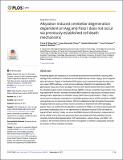Alkylation induced cerebellar degeneration dependent on Aag and Parp1 does not occur via previously established cell death mechanisms
Author(s)
Margulies, Carrie Marie; Chaim, Isaac Alexander; Mazumder, Aprotim; Criscione, June; Samson, Leona D
Downloadjournal.pone.0184619.pdf (2.055Mb)
PUBLISHER_CC
Publisher with Creative Commons License
Creative Commons Attribution
Terms of use
Metadata
Show full item recordAbstract
This is an open access article distributed under the terms of the Creative Commons Attribution License, which permits unrestricted use, distribution, and reproduction in any medium, provided the original author and source are credited. Alkylating agents are ubiquitous in our internal and external environments, causing DNA damage that contributes to mutations and cell death that can result in aging, tissue degeneration and cancer. Repair of methylated DNA bases occurs primarily through the base excision repair (BER) pathway, a multi-enzyme pathway initiated by the alkyladenine DNA glycosylase (Aag, also known as Mpg). Previous work demonstrated that mice treated with the alkylating agent methyl methanesulfonate (MMS) undergo cerebellar degeneration in an Aag-dependent manner, whereby increased BER initiation by Aag causes increased tissue damage that is dependent on activation of poly (ADP-ribose) polymerase 1 (Parp1). Here, we dissect the molecular mechanism of cerebellar granule neuron (CGN) sensitivity to MMS using primary ex vivo neuronal cultures. We first established a high-throughput fluorescent imaging method to assess primary neuron sensitivity to treatment with DNA damaging agents. Next, we verified that the alkylation sensitivity of CGNs is an intrinsic phenotype that accurately recapitulates the in vivo dependency of alkylation-induced CGN cell death on Aag and Parp1 activity. Finally, we show that MMS-induced CGN toxicity is independent of all the cellular events that have previously been associated with Parp-mediated toxicity, including mitochondrial depolarization, AIF translocation, calcium fluxes, and NAD⁺ consumption. We therefore believe that further investigation is needed to adequately describe all varieties of Parp-mediated cell death.
Date issued
2017-09Department
Massachusetts Institute of Technology. Center for Environmental Health Sciences; Massachusetts Institute of Technology. Department of Biological Engineering; Massachusetts Institute of Technology. Department of Biology; Koch Institute for Integrative Cancer Research at MITJournal
PLOS ONE
Publisher
Public Library of Science
Citation
Margulies, Carrie M. et al. “Alkylation Induced Cerebellar Degeneration Dependent on Aag and Parp1 Does Not Occur via Previously Established Cell Death Mechanisms.” Edited by Robert W Sobol. PLOS ONE 12, 9 (September 2017): e0184619 © 2017 Margulies et al
Version: Final published version
ISSN
1932-6203